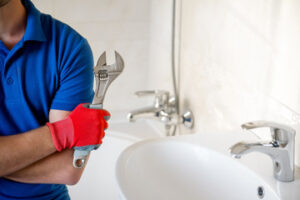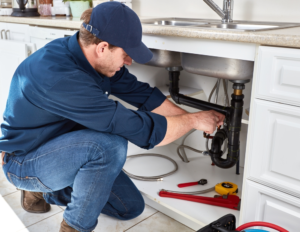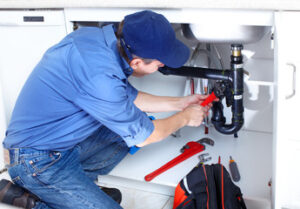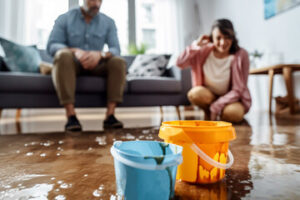When an air conditioning unit isn’t cooling a home, it usually means one or more components need repair. These components could be clogged, frozen, or simply worn out.

Before deciding on an ac repair service, homeowners should check for a license and insurance coverage. In addition, look for a company with great customer reviews. Contact AC Repair North Hollywood for professional help.
The thermostat is the brains of your AC unit. It sends a signal to the cooling system when it’s time to turn on. If your thermostat isn’t functioning properly, you may not be able to cool down your home. In some cases, the problem is as simple as replacing a battery. Before rushing to call for a professional, try these five quick and easy steps to resolve your problem.
The first thing to check is the thermostat itself. If the screen is completely dark, it’s a good idea to change the batteries. This is one of the most common causes of a non-responsive thermostat and can be solved with a simple pair of AA batteries.
Another common issue is a tripped circuit breaker. If the breaker responsible for powering the thermostat has been tripped, simply flip it back on. It’s also a good idea to check for debris around the thermostat and in the vents. Furniture, toys, drapes, and other objects can block airflow through vents and cause your ac to malfunction. It’s a good idea to perform routine maintenance on your furnace, heat pump, and ventilation system to prevent problems like this from occurring.
Thermostat problems are often due to programming issues. If the thermostat is programmed for the wrong type of equipment, running a pre-selected schedule, or has bad connections, it can cause the system to run against your home’s needs. An experienced HVAC technician can help you correct these problems quickly and easily.
Check the Condenser
An air conditioner condenser is the outdoor portion of your AC system that contains a fan, coil, various controls and a compressor. This unit collects latent heat from your home or business and moves it outdoors where it is dissipated into the atmosphere. If the condenser stops functioning properly, it can hinder your air conditioner’s overall performance and possibly lead to the system failing entirely.
The technician checks the condition of your outdoor condenser, inspecting the rust level, checking for any leaks and examining the fan and coils to make sure they are clean. He may use a rough paint brush to clear away debris that is easy to dislodge, but will usually prefer to use a garden hose set at a low pressure. This helps avoid damaging the delicate fins that characterize most outdoor condenser units.
If the large fan inside the condenser isn’t working correctly, it can’t properly circulate heat and cool air. A blown relay switch, bent blades or a malfunctioning motor can all contribute to this problem. Depending on the severity of the issue, the technician can either replace the fan motor or install a new relay switch.
Unusually high energy bills during the summer are an indication that the condenser isn’t operating effectively. This is due to a loss of efficiency that requires your system to work harder to disperse the same amount of latent heat.
Check the Evaporator
If ice forms on your evaporator coil it will greatly reduce the ability of the refrigerant to pull heat out of the air. This is a bad thing for your system because it means that the rest of the system will have to work harder to compensate, increasing your energy bills and stressing the system out, leading to early wear and failure.
The first step in checking the evaporator is to turn off the system and allow it to completely thaw. This can take up to 24 hours. It is important to note that you should never re-activate your AC after it has been defrosted because doing so can cause the evaporator coil to freeze again.
After the evaporator has thawed, it’s time to start looking at the possible causes of the problem. Some of these problems can be as simple as a dirty air filter or blocked return air ducts. Other problems can be more complicated, like a frozen evaporator coil or low refrigerant levels. If the problem is more complex, a professional needs to be consulted for further testing and repair.
In order to properly check the evaporator coil, it is important to perform proper bubble testing and make sure that it was thoroughly evacuated during installation. To do this, a special vacuum gauge (not a manometer) should be used to create negative pressure. A video scope may also be necessary to get an accurate picture of the evaporator coil and its connections. Once a positive screen has been accomplished, it is a good idea to apply a sealant such as BIG BLU to any suspect surfaces. The best areas to begin searching for leaks are the suction and discharge lines due to their large surface area. However, it is recommended to spray coat all of the fittings starting with the compressor and suction line, then moving on to the condenser coil U-joints, and finally the liquid line connection at the evaporator section.
Check the Ductwork
The ductwork is one of the most important components in your AC system. If the ductwork is leaking, it will cause hot and cold spots in your home and it will also increase your utility bills. You should check your ductwork regularly for holes, breaks, and disconnected sections. You should also check the airflow through each register. If you have trouble getting air to flow through your ducts, it may be caused by blockages or a faulty HVAC.
Signs that your ductwork is leaking include a stuffy feeling, high energy bills, and dust buildups in the living spaces of your home. When conditioned air escapes through the leaks in your ducts, it can disturb dust accumulations and force them into open areas. This can lead to asthma and other respiratory distress.
A professional can conduct an inspection of your ductwork to identify problems. They can also repair the ducts to make sure that they are properly sealed. However, you can do a basic duct inspection yourself by doing a tour of your house in the evening with your heater or air conditioner running. Close all the interior room doors, and walk around your home, looking for gaps in ducts or bare sections of ducting.
You can purchase a smoke pencil at your local hardware store to use to inspect your ducts for leaks. It will cost around $30 and will give you a good idea of the size of any leaks in your ducts. Once you have found any leaks, you can patch them up with aluminum foil tape or mastic sealant. Make sure you use the mastic sealant on joints and seams, not in the corners of the ducts.
Check the Compressor
The compressor is essentially an electric motor. This means that it can also experience the same problems as an electric motor, including shorts, becoming grounded, or having open windings. To check for these problems, you’ll need a multimeter with a continuity setting. You’ll also need to shut off the power at the compressor disconnect box before you remove any wires or take any measurements.
Using your multimeter, test the connections to the compressor by placing one lead on the C terminal and the other on the S terminal. If you get a reading of infinity (OL) between the S and C terminals, the compressor is most likely stuck in “locked rotor amps” mode. This is a safety feature that protects the compressor from excessive loads and high temperatures by locking up the rotor until it cools down. The compressor will make a loud humming noise as it rotates in this mode, and it may be extremely hot to the touch.
If the rotor is locked up, but the other tests indicate everything is fine, you might need to rewire the compressor. This could be due to a tripped circuit breaker, blown fuse, mismatched indoor and outdoor units, or damaged wiring.
It’s important to note that any 3 phase electrical equipment is typically 460 volts and can cause severe injury or death if you don’t follow proper procedures. Always consult a professional for help with this type of work.






